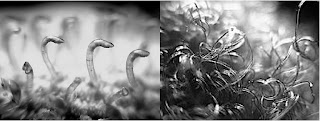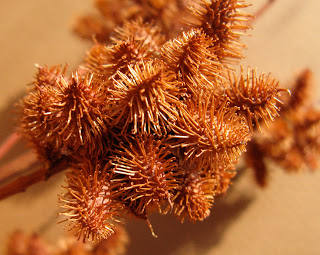UPDATE: see
Devils Tower--what's on top? (updated) for results of a 2016 botanical study of the summit.
 |
Devils Tower, in the Black Hills in northeast Wyoming, USA.
Photo by John C. H. Grabill, ca. 1888. |
Devils Tower National Monument is a small park containing a huge rock -- a giant truncated fluted monolith that rises 800 feet above the pine ridges and prairies of the northwest Black Hills. The park is only about a square mile in area, with a significant chunk of that taken up by igneous intrusive rock (phonolite porphyry), but it includes a good representation of the area’s vegetation: ponderosa pine forest; woody draws with bur oak, green ash, hawthorne, chokecherry and wild plum; mixed grass prairie; and riparian woodland along the Belle Fourche River. But what’s on top?
 |
Devils Tower from the air, middle left; Belle Fourche River on right has exposed
Permo-Triassic redbeds of the Spearfish Formation. Courtesy ArcGIS Online. |
The broad rolling summit of Devils Tower is covered in rocks, grass, cactus, wildflowers, and surprisingly, sagebrush -- specifically Wyoming big sagebrush, Artemisia tridentata ssp. wyomingensis. Why is this a surprise? because big sagebrush is uncommon in the Black Hills, restricted to the margins of the uplift. It is characteristic of drier habitats in the basins to the west. The Black Hills, even at lower elevations, are more mesic (moist), with forests, woodlands and relatively-lush mixed-grass prairies, like those of the Great Plains to the east.
It’s wonderful when nature surprises us like this -- it gives us a chance to think and speculate, to come up with an explanation. Although the top of the Tower receives the same amount of precipitation as the surrounding area, I suspect is it effectively drier due to the rocky substrate with limited soil development. Sagebrush is better suited for this site.
 |
Collecting vegetation data on the summit of the Tower ... someone has to do it.
Little Missouri Buttes in background are igneous intrusions similar to Devils Tower. |
At least 28 vascular plant species grow on the summit of Devils Tower, including several others characteristic of the sagebrush grasslands of the basins to the west, such as prickly pear cactus and bluebunch wheatgrass.
What's on top:
western yarrow (Achillea millefolium)
wild onion (Allium textile)
fringed sagebrush (Artemisia frigida)
Wyoming big sagebrush (Artemisia tridentata ssp. wyomingensis)
rockcress (Arabis holboellii)
blue grama (Bouteloua gracilis)
cheatgrass (Bromus tectorum)
sego lily (Calochortus nuttallii)
harebell (Campanula rotundifolia)
field sedge (Carex praegracilis)
one-spike oatgrass (Danthonia unispicata)
western tansymustard (Descurainia pinnata)
small draba (Draba nemorosa)
Junegrass (Koeleria macrantha)
stickseed (Lappula redowskii)
plains muhly grass (Muhlenbergia cuspidata)
prickly pear cactus (Opuntia polyacantha)
broomrape (parasitic on sagebrush) (Orobanche fasciculata)
Sandberg bluegrass (Poa secunda)
cinquefoil (Potentilla pensylvanica)
bluebunch wheatgrass (Pseudoroegneria spicata)
skunkbush (Rhus trilobata)
gooseberry (Ribes setosum)
spike moss (Selaginella densa)
needle-and-thread (Stipa comata)
meadow salsify (Tragopogon dubius)
sixweeks fescue (Vulpia octoflora)
woodsia fern (Woodsia sp.)
 |
Devils Tower National Monument is located near Hulett, Wyoming, in the
northwest part of the Black Hills. Courtesy Google Maps. |


















































